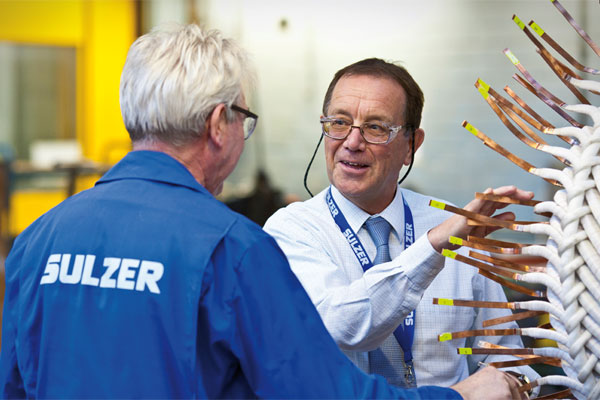Gas turbine rotor repair
Fit to meet ever-increasing power demands
As a result, the number of industrial gas turbines in service continues to rise and along with this, their technology has significantly evolved over the last 50 years to meet ever-increasing demands. Manufacturers are compelled to develop much larger turbines designed for unremitting operations. Consequently, industrial gas turbines operating in these environments require periodic repairs, a task that calls for considerable expertise, precision and capital equipment investment.
Billy Bottera, Manager of Gas Turbine Rotor Repairs, at Sulzer’s Houston Service Center, near La Porte, Texas, explains the processes and state-of-the-art equipment involved in repairing some of these large, modern gas turbine rotors.
Original Equipment Manufacturers (OEM) of industrial gas turbines often persuade owners/operators to accept long-term service agreements (LTSA) that involve all of the maintenance operations being completed by the OEM. These agreements can offer financial stability, technical expertise and continuous monitoring and diagnostics.
However, all operators do not necessarily agree to an LTSA or they allow the agreements to expire due to cost-saving measures. Thus, some operators are seeking alternative repair providers. As a result, independent repair facilities, like Sulzer, continue to grow as operators have the luxury to review these other options in the independent repair sector.
In order to select the most adept repair specialist, it is important to understand the maintenance and repair process, to scrutinize the facilities, equipment, expertise and precision that are required not only for maintenance, but also for highly-specialized repairs. Turbine operators require a one-stop service facility where maintenance providers are capable of delivering a complete repair, including all phases of the repair process.
The massive size of modern, industrial gas turbine rotors means that a repair facility must be equipped with cutting-edge equipment sufficiently capable of lifting, balancing and machining a fully assembled rotor. Having the appropriate large-scale equipment to handle these turbine rotor refurbishments is critical to the processes and workflow involved in the repair process. In the past, cranes and lathes that could accommodate approximately 120,000 lbs. were adequate, but as the output capacity of industrial gas turbines has increased, so has the weight of the rotors.
Meticulous inspection process
To begin the repair process, the initial inspection starts with the balance machine, which can identify any as received unbalance issues before the rotor is disassembled. In order to accomplish this, Sulzer installed a custom-built, dynamic balancing machine, capable of balancing rotors up to 180,000 lbs.
After the initial balance run, the rotor is then placed into V-blocks (run-out stands) and is rotated by a hydraulic belt-drive unit, or by hand for smaller rotors, which allows all of the critical inspections and dimensions to be performed as well as a visual assessment of the rotor. The results of these initial inspections will determine if the rotor needs to be disassembled, a process that begins with upending the rotor and placing it in a stacking pit. In addition to the large balancing machine, Sulzer invested in a large, vertical stacking system. Positioning a rotor in a stacking pit provides a stable working platform, unlike scaffolding, for protecting delicate rotors and providing a safe, stable work platform.
Modern rotors have increased in length as well as weight so the crane capacity has also been a restricting factor in the past at most facilities. At Sulzer, a 100-ton crane with a 50’ height capacity enables compressor and turbine section separation as well as individual component removal of either compressor or turbine section.
Once disassembled, inspections are focused on the individual components of the respective compressor or turbine parts. Each part is thoroughly examined and inspected in detail for reuse or specialized repairs such as replacing blades or coating compressor disks. The individual disks go through concentricity checks and are balanced in a horizontal balance stand before being reassembled. After qualification of individual components, each section is dynamically balanced and prepared for assembly.
Comprehensive facilities improve workflow
After reassembly, the compressor section and the turbine section are placed in the lathe to check run-outs and machine or correct the rotor if necessary. To maintain its leadership position in the industry, Sulzer recently installed a new, state-of-the-art, large and versatile lathe that was built to accommodate large gas turbine rotors. Specifically designed for versatility and to hold the most modern turbine rotors, the lathe has a 198,000 lbs. capacity, with a 76 foot (23 meters) over bedway and a 14 foot (4.25 meters) swing.
The new large, versatile lathe complements the capabilities of the horizontal balancing machine, 180,000 lbs balance stand and vertical stacking lift. This combination and arrangement makes the most efficient use of the workshop space and speeds up the workflow by reducing the time required to repair a rotor.
Each rotor section is then rechecked for balance before returning to the stacking pit where the major sections are mated. The complete rotor is then ready for final checks and dynamic balancing before being shipped back to the customer.
Dealing with a single rotor is a relatively straight forward task with suitable shop facilities and equipment, but coordinating the repairs to multiple rotors and minimizing the time between each stage is a more complicated issue. Forward planning, excellent project management skills and a range of versatile equipment enables today’s repair specialists to deliver cost effective, timely and successful projects.
In each case, there is always a huge amount of support required; from specialist machining to new blade manufacture and specialized coatings. A considerable amount of repair engineering goes into the finished rotor. However, for the client, the most crucial aspect is speed and minimizing downtime, which can be achieved by selecting a maintenance partner that has the capacity and expertise to deliver the project on time.



